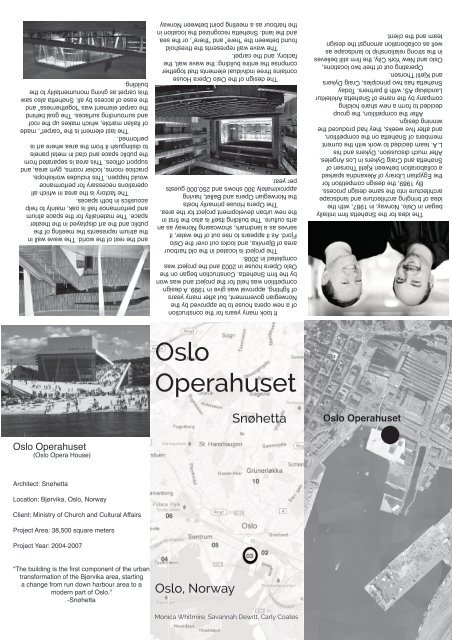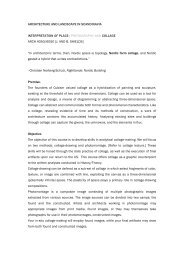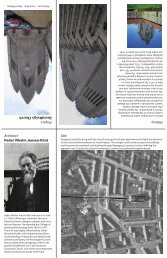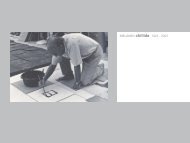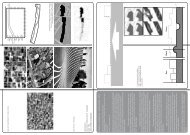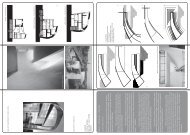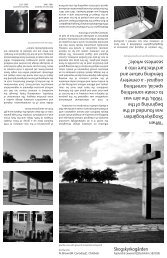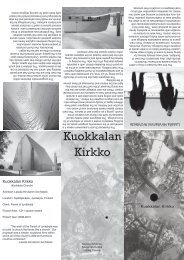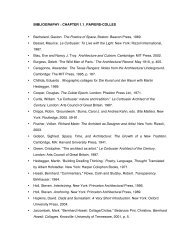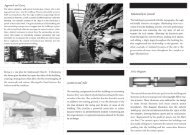Olso Operahuset - collage and architecture
Olso Operahuset - collage and architecture
Olso Operahuset - collage and architecture
You also want an ePaper? Increase the reach of your titles
YUMPU automatically turns print PDFs into web optimized ePapers that Google loves.
The idea for the Snøhetta firm initially<br />
began in Oslo, Norway, in 1987, with the<br />
idea of bringing <strong>architecture</strong> <strong>and</strong> l<strong>and</strong>scape<br />
<strong>architecture</strong> into the same design process.<br />
By 1989, the design competition for<br />
the Egyptian Library of Alex<strong>and</strong>ria sparked<br />
a collaboration between Kjetil Thorsen of<br />
Snøhetta <strong>and</strong> Craig Dykers in Los Angeles.<br />
After much discussion, Dykers <strong>and</strong> his<br />
L.A. team decided to work with the current<br />
members of Snøhetta on the competition,<br />
<strong>and</strong> after five weeks, they had produced the<br />
winning design.<br />
After the competition, the group<br />
decided to form a new share holding<br />
company by the name of Snøhetta Arkitektur<br />
L<strong>and</strong>skap AS, with 8 partners. Today<br />
Snøhetta has two principles, Craig Dykers<br />
<strong>and</strong> Kjetil Thorsen.<br />
Operating out of their two locations,<br />
Oslo <strong>and</strong> New York City, the firm still believes<br />
in the strong relationship to l<strong>and</strong>scape as<br />
well as collaboration amongst the design<br />
team <strong>and</strong> the client.<br />
It took many years for the construction<br />
of a new opera house to be approved by the<br />
Norwegian government, but after many years<br />
of fighting, approval was give in 1999. A design<br />
competition was held for the project <strong>and</strong> was won<br />
by the firm Snøhetta. Construction began on the<br />
Oslo Opera house in 2003 <strong>and</strong> the project was<br />
completed in 2008.<br />
The project is located in the old harbour<br />
area of Bjørvika, <strong>and</strong> looks out over the Oslo<br />
Fjord. As it appears to rise out of the water, it<br />
serves as a l<strong>and</strong>mark, showcasing Norway as an<br />
arts culture. The building itself is also the first in<br />
the new urban development project for the area.<br />
The Opera House primarily hosts<br />
the Norwegian Opera <strong>and</strong> Ballet, having<br />
approximately 300 shows <strong>and</strong> 250,000 guests<br />
per year.<br />
The design of the Oslo Opera House<br />
contains three individual elements that together<br />
comprise the entire building: the wave wall, the<br />
factory, <strong>and</strong> the carpet.<br />
The wave wall represents the threshold<br />
found between the “here” <strong>and</strong> “there”, or the sea<br />
<strong>and</strong> the l<strong>and</strong>. Snøhetta recognized the location in<br />
the harbour as a meeting point between Norway<br />
<strong>and</strong> the rest of the world. The wave wall in<br />
the atrium represents the meeting of the<br />
public <strong>and</strong> the art displayed in the theater<br />
space. The materiality for the space atrium<br />
<strong>and</strong> performance hall is oak, mainly to help<br />
acoustics in both spaces.<br />
The factory is the area in which all<br />
operations necessary for performance<br />
would happen. This includes workshops,<br />
practice rooms, locker rooms, gym area, <strong>and</strong><br />
support offices. This area is separated from<br />
the public space <strong>and</strong> clad in metal panels<br />
to distinguish it from the area where art is<br />
performed.<br />
The last element is the “carpet”, made<br />
of Italian marble, which makes up the roof<br />
<strong>and</strong> surrounding surfaces. The goal behind<br />
the carpet element was “togetherness” <strong>and</strong><br />
the ease of access by all. Snøhetta also saw<br />
this carpet as giving monumentality to the<br />
building.<br />
Oslo<br />
<strong>Operahuset</strong><br />
Snøhetta<br />
Oslo <strong>Operahuset</strong><br />
Oslo <strong>Operahuset</strong><br />
(Oslo Opera House)<br />
Architect: Snøhetta<br />
Location: Bjørvika, Oslo, Norway<br />
Client: Ministry of Church <strong>and</strong> Cultural Affairs<br />
Project Area: 38,500 square meters<br />
Project Year: 2004-2007<br />
“The building is the first component of the urban<br />
transformation of the Bjørvika area, starting<br />
a change from run down harbour area to a<br />
modern part of Oslo.”<br />
-Snøhetta<br />
Oslo, Norway<br />
Monica Whitmire, Savannah Dewitt, Carly Coates
The building is approached by way of a footbridge to the north of the<br />
building. The bridge leads into an open plaza that leads one directly<br />
to the main entrance located on the northern façade. The entrance is<br />
tucked under a sloped section of the plaza that extends up to connect<br />
with the rooftop. Occupants enter into a large lobby where the “wave<br />
wall” is located.<br />
Oslo<br />
Opera<br />
House<br />
Bjørvika<br />
Ground Floor Plan<br />
The opera house is set as the focal point for someone approaching from<br />
the mouth of the fjord. It st<strong>and</strong>s alone at the water’s edge in front of an<br />
urban backdrop, surrounded by many paths for transportation but quite<br />
separated from other built context.<br />
North Elevation<br />
Roof Plan<br />
South Elevation<br />
The sloped, traversable rooflines of the<br />
building (or the “carpet”) seem to mimic<br />
the sloping ground line where the city<br />
meets the water. The plaza itself even<br />
dips down into the water, symbolizing<br />
a give-<strong>and</strong>-take relationship between<br />
the urban <strong>and</strong> natural conditions.<br />
Public / Viewing<br />
Rehearsal Space<br />
Hard Workshops<br />
Soft Workshops<br />
Public<br />
Semi-Private<br />
Private<br />
The opera house is divided into<br />
sections based on program. In their<br />
plans for the building, the designers<br />
decided early on that they wanted<br />
to use industrial material to<br />
designate the work space, or<br />
“factory”, from other spaces within<br />
the building. It seems that the<br />
designers also designated program<br />
quadrants with the addition of<br />
certain walkways. The north-south<br />
corridor, which is referred to as<br />
the “opera street”, separates the<br />
public <strong>and</strong> performance spaces<br />
from the offices, workshops, <strong>and</strong> changing rooms. The eastwest<br />
oriented loading dock in the “factory” section of the building<br />
separates the work spaces into hard workshops (for scenery) to the<br />
north <strong>and</strong> soft workshops (costuming, makeup, etc.) to the south.<br />
East-West Section<br />
Sectionally, the building seems to alternate tall, open spaces<br />
with stacked floors. It incorporates several multiple-levelheight<br />
spaces that the more concentrated spaces open into,<br />
so that no space ever feels completely contained.


